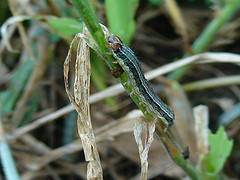Here Today, Gone Tomorrow
Nashville, Ark. – Those of you who have recently had a bout of armyworms know exactly what I am talking about. One day your pasture, yard, or garden looks great. Step out on the porch the next day for your morning coffee…it is gone! Yes, they work that quickly
How to determine whether you’ve got them or not: they are usually active during the morning and early evening, so that is the best time to scout for them. Get out of the pickup or off the tractor and do a walkabout in your pasture, yard, etc. They are not hard to spot. Another big hint you’ve got them is large gatherings of egrets, black birds, or crows (HUGE CLUE). If you do find a caterpillar or two, the best way to recognize an armyworm is the inverted “Y” on the top of its head. Their color can vary from light tan to gray, but they will always have the inverted “Y”.
Now how do you determine if you should treat and how should you treat these ravenous caterpillars. First, are they in the economic threshold treatment level? And what is that? If you find three or more worms in one square foot, you’d better get the spray rig or hay baler ready. Options for control: do you spray or do you cut? Two very good questions. If you were planning to cut and it is close to being ready, get after it! Don’t wait! These little critters can destroy 40 acres in 2 days and you won’t even see it coming until it is too late. The mechanical process of cutting, raking and baling hay will kill the majority of the worms you have. If some do survive they may feed on the stubble, but shouldn’t do permanent damage to perennial forage crops. Were you going to extend your grazing into the fall? Then spray. Sevin is the most readily available product we have, but remember to read the label; it does have grazing and haying restrictions.
If you have any questions, or would like more information on armyworms, please feel free to contact me at the Howard County Extension Office at 870-845-7517. For your free copy of Managing Armyworms in Pastures and Hayfields, call the office and ask for fact sheet FSA7083.
By Sherry Beaty-Sullivan
County Extension Agent - Agriculture
The Cooperative Extension Service
U of A System Division of Agriculture
Media Contact: Sherry Beaty-Sullivan
County Extension Agent - Agriculture
U of A Division of Agriculture
Cooperative Extension Service
421 N. Main Nashville AR 71852
(870) 845-7517
sbeaty@uada.edu
Related Links
The Arkansas Cooperative Extension Service is an equal opportunity institution. If
you require a reasonable accommodation to participate or need materials in another
format, please contact your County Extension office (or other appropriate office)
as soon as possible. Dial 711 for Arkansas Relay.
Pursuant to 7 CFR § 15.3, the University of Arkansas System Division of Agriculture
offers all its Extension and Research programs and services (including employment)
without regard to race, color, sex, national origin, religion, age, disability, marital
or veteran status, genetic information, sexual preference, pregnancy or any other
legally protected status, and is an equal opportunity institution.
